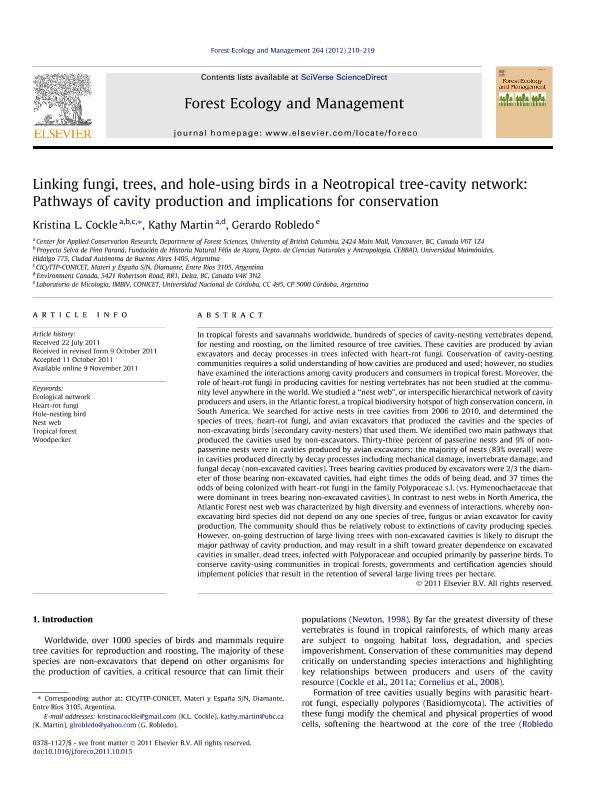Artículo
Linking fungi, trees, and hole-using birds in a Neotropical tree-cavity network: Pathways of cavity production and implications for conservation
Fecha de publicación:
01/2012
Editorial:
Elsevier Science
Revista:
Forest Ecology and Management
ISSN:
0378-1127
Idioma:
Inglés
Tipo de recurso:
Artículo publicado
Clasificación temática:
Resumen
In tropical forests and savannahs worldwide, hundreds of species of cavity-nesting vertebrates depend, for nesting and roosting, on the limited resource of tree cavities. These cavities are produced by avian excavators and decay processes in trees infected with heart-rot fungi. Conservation of cavity-nesting communities requires a solid understanding of how cavities are produced and used; however, no studies have examined the interactions among cavity producers and consumers in tropical forest. Moreover, the role of heart-rot fungi in producing cavities for nesting vertebrates has not been studied at the community level anywhere in the world. We studied a " nest web" , or interspecific hierarchical network of cavity producers and users, in the Atlantic forest, a tropical biodiversity hotspot of high conservation concern, in South America. We searched for active nests in tree cavities from 2006 to 2010, and determined the species of trees, heart-rot fungi, and avian excavators that produced the cavities and the species of non-excavating birds (secondary cavity-nesters) that used them. We identified two main pathways that produced the cavities used by non-excavators. Thirty-three percent of passerine nests and 9% of non-passerine nests were in cavities produced by avian excavators; the majority of nests (83% overall) were in cavities produced directly by decay processes including mechanical damage, invertebrate damage, and fungal decay (non-excavated cavities). Trees bearing cavities produced by excavators were 2/3 the diameter of those bearing non-excavated cavities, had eight times the odds of being dead, and 37 times the odds of being colonized with heart-rot fungi in the family Polyporaceae s.l. (vs. Hymenochaetaceae that were dominant in trees bearing non-excavated cavities). In contrast to nest webs in North America, the Atlantic Forest nest web was characterized by high diversity and evenness of interactions, whereby non-excavating bird species did not depend on any one species of tree, fungus or avian excavator for cavity production. The community should thus be relatively robust to extinctions of cavity producing species. However, on-going destruction of large living trees with non-excavated cavities is likely to disrupt the major pathway of cavity production, and may result in a shift toward greater dependence on excavated cavities in smaller, dead trees, infected with Polyporaceae and occupied primarily by passerine birds. To conserve cavity-using communities in tropical forests, governments and certification agencies should implement policies that result in the retention of several large living trees per hectare. © 2011 Elsevier B.V.
Archivos asociados
Licencia
Identificadores
Colecciones
Articulos(CICYTTP)
Articulos de CENTRO DE INV.CIENT.Y TRANSFERENCIA TEC A LA PROD
Articulos de CENTRO DE INV.CIENT.Y TRANSFERENCIA TEC A LA PROD
Citación
Cockle, Kristina Louise; Martin, Kathy; Robledo, Gerardo Lucio; Linking fungi, trees, and hole-using birds in a Neotropical tree-cavity network: Pathways of cavity production and implications for conservation; Elsevier Science; Forest Ecology and Management; 264; 1-2012; 210-219
Compartir
Altmétricas




